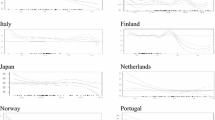Abstract:
We have searched for correlations and anticorrelations with respect to currencies as CHF, DKK, JPY, and USD in order to understand the EUR behavior. In order to do so we have invented a false euro (FEUR) dating back to 1993 and have derived simulated exchange rates of the FEUR. Within the Detrended Fluctuation Analysis (DFA) statistical method we have obtained the power law behavior describing the rms. deviation of the fluctuations as a function of time. We have compared the time-dependent exponent for these four exchange rates, and observe the role of the DEM, and the other currencies forming the EUR. A simple investment strategy based on the local DFA technique shows one can obtain appreciable gains, even taking into account some modest transaction fee. We compare the time dependent α exponent of the DFA for various exchange rates as in a correlation matrix for estimating respective influences.
Similar content being viewed by others
Author information
Authors and Affiliations
Additional information
Received 31 August 2000
Rights and permissions
About this article
Cite this article
Ausloos, M., Ivanova, K. False Euro (FEUR) exchange rate correlated behaviors and investment strategy. Eur. Phys. J. B 20, 537–541 (2001). https://doi.org/10.1007/s100510170235
Issue Date:
DOI: https://doi.org/10.1007/s100510170235




